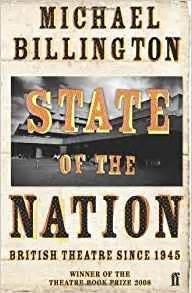| State of the Nation- The Middle Decade |
Theatre History |
| Michael Billington , Faber & Faber , December 16, 2007 |
 The middle decades of this notable book differ from those that have preceded. Michael Billington becomes a part of theatre's ecology. “In October 1971” he writes “I was invited by Peter Preston to become drama critic of the “Guardian” which was the start of a durable professional marriage.” He adds a line to attest to domestic happiness. The role in the seventies was not as it is thirty years on. Along with first nights and travel came presenting arts programmes for radio and television.
The middle decades of this notable book differ from those that have preceded. Michael Billington becomes a part of theatre's ecology. “In October 1971” he writes “I was invited by Peter Preston to become drama critic of the “Guardian” which was the start of a durable professional marriage.” He adds a line to attest to domestic happiness. The role in the seventies was not as it is thirty years on. Along with first nights and travel came presenting arts programmes for radio and television. The nation of the title is of course England and it is an England of London and Stratford. Chichester pops up as an honorary extension of London. The building of the Royal Exchange is noted, along with its inspirational leadership under Michael Elliott. 7:84 appears only because “the Stag, the Cheviot...” was a stand-out. The only other reference to Scotland is the creation of the Traverse in 1963. It gets a mention in a sentence as precursor to Jim Haynes founding the Arts Lab in a cellar in Drury Lane. The book's approach is probably right. London does dominate and the sixties were London's time. Its theatre geography is precisely noted. Charles Marowitz and Thelma Holt founded the Open Space “off the Tottenham Court Road.” Ed Berman created the Ambiance Theatre in Baywsater [sic]. These were the years of Monstrous Regiment, Foco Novo, Hull Truck and Black Theatre Co-Operative. The names of theatre that persist into today make their first appearances. Tom Stoppard enters with a novel in 1966 “Lord Malquist and Mr Moon”, a macabre farce with the funeral of Churchill as its background. Glenda Jackson is on stage in a tight black dress and high heels. Soon she is in a tin bath and naked. Peter Brook is director. Other directors debut in these years, the names including Lindsay Anderson and Trevor Nunn, Hands and Hytner, Bill Bryden and Katie Michell. The sheer span of theatre is essentially uncatchable. Billington attempts a taxonomy that he admits does not adequately fit. Thus Ayckbourn, Hampton, Pinter and Stoppard are grouped as “Contemporary Classicists” but only “for want of a better term.” The other two categories are “Disturbers of the Peace” and “Anatomists of Albion”. The disturbers are Barnes and Bond, Orton and Wood. The last grouping includes Bennett, Nicholas, Osborne and Storey. It is a densely packed book in which the criticism moves in on a selection of productions as central. “The Homecoming” naturally is one. “Saved” “Loot”, “Fanshen”, “Company”,“the Oresteia” follow. David Hare received a commercial production at an astonishingly young age with “Knuckle”. That play and “Plenty” receive the indepth critiques. It was also the time of Roy Jenkins and Alice Bacon at the Home Office. Censorship went although the Lord Chamberlain goes down fighting to the end. “Abelard and Eloise” got huge publicity for the nakedness of its principals. Audiences were never to know if it were the case as the scene was played in near total darkness. It was the period too of “the Romans in Britain”, the only appearance of Michael Bogdanov in the book. Theatre is simply too big to get in its entirety and the Old Vic may well have been a journey too far. Omissions are inevitable. “Jumpers”, an effervescent mix of logical positivism, acrobatics and murder gets several paragraphs. But Brook's “A Midsummer Night's Dream” gets only the adjectives “magical” and “Meyergoldian.” The relationship between a book and its reader is particular. The years between fifteen and twenty-five are the ones of greatest receptivity. The tastes for life are set. The small drama gang at my school mounted lunchtime scenes of “Serjeant Musgrave's Dance” and “Early Morning”. (The latter it was let known by a tolerant teacher-hood was a step too far.) Abigail's Party” and “Destiny” were dramatised for television. “Plenty” I saw in the 90s with Cate Blanchett. “Afore Night Come”, “Loot” and “the Philanthropist” I saw in revival, a virtue of “regional theatre.” I was taken to the first tours of “Saved” and “Rosencrantz and Guildenstern.” “Equus”, “Jumpers”, Knuckle”,“the Old Country”, “the Philanthropist”, “Privates on Parade”, “Comedians”, “Otherwise Engaged”, “Once a Catholic” had among many Edward Fox, Kate Nelligan, Michael Hordern, Felicity Kendall, Alan Bates, Alec Guinness, Dennis Quilley, Alan Bates, Colin Blakely. My first working life was in London and I saw them all. “State of the Nation” is history but I am not an impartial reader. It is also my biography. |
Reviewed by: Adam Somerset |
This review has been read 1448 times There are 31 other reviews of productions with this title in our database:
|
